Anambas Islands Development
1. Introduction
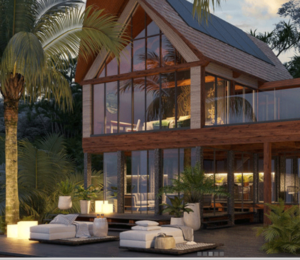 In this Anambas Islands Development article we outline the Anambas islands development opportunities and how to capitalise on them. This article merges historical context, socio-economic insights, legal frameworks, and real-world examples (including a Bawah Reserve case study) to provide a holistic resource on developing in the archipelago. We will delve into land titles, zoning, designated development zones, and the precise steps that guide large-scale projects from concept to operation.
In this Anambas Islands Development article we outline the Anambas islands development opportunities and how to capitalise on them. This article merges historical context, socio-economic insights, legal frameworks, and real-world examples (including a Bawah Reserve case study) to provide a holistic resource on developing in the archipelago. We will delve into land titles, zoning, designated development zones, and the precise steps that guide large-scale projects from concept to operation.
Drawing on the experiences of Kepri Estates and others, we also examine property acquisition procedures for foreign entities, highlight land-price comparisons, and discuss how eco-conscious design can yield strong returns. By the end, readers should grasp both the compelling business case for investing in the Anambas and the exceptional opportunity for high environmental, social and governance (ESG) developments in this tropical wilderness less than 300 km from Singapore.
Contents
- Introduction
- Historical Context of Economic Activity and Anambas Islands Development
- Geographic Profile and Strategic Significance
- Socioeconomic Landscape and Emerging Opportunities
- Infrastructure Developments and Connectivity
- Environmental Considerations and Sustainability
- Anambas Islands Land Titles
- Anambas Islands Zoning Types
- Anambas Islands Development Zones
- Policy and Regulatory Frameworks
- The Anambas Islands Development Process
- The Unique Value Proposition
- Future Outlook and Conclusion
2. Historical Context of Economic Activity and Anambas Islands Development
 Maritime Trade Roots
Maritime Trade Roots
For centuries, the broader Riau Islands connected major trade routes linking China, the Malay Peninsula, and other parts of Southeast Asia. Chinese, Arab, and Malay traders passed through the region, transporting spices, textiles, and assorted commodities. However, the more remote Anambas Islands received fewer large-scale visits than major trading hubs during this time, and were utilised mainly for refuge and resupply of trading vessels.
Colonial Era and Post-Independence Evolution
During Dutch colonial rule, the archipelago remained on the periphery, witnessing minimal external investment. Artisanal fishing sustained local communities, and the area’s geographic remoteness kept it isolated from regional commerce. Once Indonesia gained independence (1945), government focus on “outer islands” began to shift and gradual infrastructure upgrades opened the door for Anambas Islands Development, though progress remained slower than expansions in Batam or Bintan.
Modern Emergence
As Indonesia’s economic priorities evolved, officials recognized that these remote islands held strategic maritime and tourism potential. Investors, both local and international, started paying attention to this archipelago for its unspoiled natural beauty, cheap property prices and supportive local policies. Consequently, Anambas islands development began accelerating in the early 21st century and has started to transform the region into a balanced model of growth and sustainability.
More information on Anambas islands history can be found in our comprehensive article on Anambas Islands History.
3. Geographic Profile and Strategic Significance
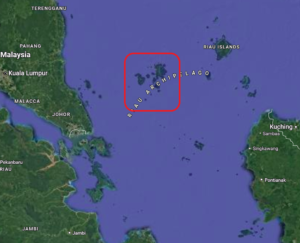 Comprising around 255 islands (though only some are inhabited), the Anambas lie northeast of Singapore, roughly between Borneo (Kalimantan) and Peninsular Malaysia. Their location places them within a busy maritime corridor known for robust fishing grounds, coral reefs, and seagrass meadows. Since the Anambas Islands fall under the Coral Triangles’ biodiversity hotspot, their waters harbor countless reef species, sea turtles, reef sharks, and transiting wildlife like whale sharks.
Comprising around 255 islands (though only some are inhabited), the Anambas lie northeast of Singapore, roughly between Borneo (Kalimantan) and Peninsular Malaysia. Their location places them within a busy maritime corridor known for robust fishing grounds, coral reefs, and seagrass meadows. Since the Anambas Islands fall under the Coral Triangles’ biodiversity hotspot, their waters harbor countless reef species, sea turtles, reef sharks, and transiting wildlife like whale sharks.
Physical Features
The key features of the Anambas island for developers consideration are,
- Coastal Diversity– White-sand beaches, steep cliffs, and sheltered coves offer dramatic variations in tropical beach scenery.
- Marine Ecosystems: Vibrant coral gardens sustain fisheries, invite recreational divers and provide superior guest experiences.
- Terrain: Larger islands feature hilly or mountainous interiors, often covered in virgin tropical rainforests.
The Geography of the Anambas Islands article has more details about the bathymetry, topography and points of interest in the Anambas Islands.
4. Socioeconomic Landscape and Emerging Opportunities
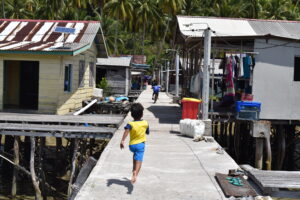 Although the population remains modest (tens of thousands), it grows steadily, with younger generations now receiving improved schooling. Many locals rely on small-scale fishing and nearshore reefs for daily subsistence. However, rising global seafood demand has increased fishing pressures.
Although the population remains modest (tens of thousands), it grows steadily, with younger generations now receiving improved schooling. Many locals rely on small-scale fishing and nearshore reefs for daily subsistence. However, rising global seafood demand has increased fishing pressures.
Meanwhile, newly expanding tourism offers a second pathway for job creation, and has the potential to offer environmental benefits by offering employment away from unregulated fishing and other sources of income that may negatively affect the pristine environment.
Economic Pillars
Main sources of income for the population of the Anambas islands are.
- Fisheries – The main source of income with live export of high value finfish and harvesting of squid being the main income producers.
- Tourism – Clear waters and natural beauty attract adventurous travellers, divers, and more recently, luxury eco travellers.
- Agriculture and Aquaculture – Limited arable land constraints exist, but pockets of coconut groves, cloves and tropical fruits exist, and aquaculture high value finfish is becoming a significant income producer for the local population.
- Services and Retail – The main towns of Terempa and Letung offer general retail and services for the local population.
Potential
Anambas Islands Development in tourism, logistics, and real estate can generate substantial gains across the investment and ESG spectrum, from high-value and premium hospitality offerings right through to local empowerment, and by aligning with local leaders and frameworks, external investors are likely to succeed in both business and community engagement for mutual gain.
5. Infrastructure Developments and Connectivity
 Ongoing infrastructure investments by all tiers of government continues to improve accessibility and logistics capacity for both residents and to continue to attract increasing levels of foreign investment. Some key infrastructure initiatives are.
Ongoing infrastructure investments by all tiers of government continues to improve accessibility and logistics capacity for both residents and to continue to attract increasing levels of foreign investment. Some key infrastructure initiatives are.
Air Transport
- Matak Airport and Letung Airport – These small airports handle regional domestic flights (e.g., from Tanjung Pinang) and charter planes. Previous and planned runway extensions and immigration facilities will facilitate direct links to regional international airports.
Sea Transport
- Passenger Ferries – Tarempa on Siantan Island (East), and Letung on Jemaja island (West) are the ferry hubs connecting the Anambas with Tanjung Pinang, Batam, and other main Riau Islands. Improved ferry schedules continue attracting new domestic tourists.
- Cargo Vessels – Ongoing upgrades to both Letung and Terempa cargo facilities significantly reduces logistics costs, and future bonded stores will provide direct importing facilities for developers to stage materials adjacent to development sites, further reducing lead times and costs for development.
For further research, the article How to get to the Anambas Islands has all the details on how to get to the Anambas now, and what the options will be in the short term, the article Getting Around in the Anambas Islands has the routes and main transport methods between key areas and Where to Stay in the Anambas Islands provides the locations and accommodation types available to you when you get there.
Utilities
- Electricity – Diesel-based power grids dominate, though Bawah Reserve employs solar panels and hybrid systems to minimise their carbon footprint.
- Water Supply – Most communities rely on rainwater collection, wells, or local desalination. The provinces annual rainfall of over 1,900mm per year provides ample opportunity for low cost potable water generation.
- Telecom – 4G mobile data now covers most population centres, and the recent Telkomsel / Starlink agreement now ensures high speed voice and data will be available for any remote developments.
6. Environmental Considerations and Sustainability
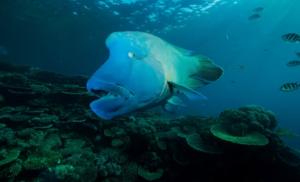 Preserving marine and coastal habitats is essential, since the region’s pristine nature is a cornerstone of its premium ecotourism appeal, and a backbone for local commerce. Fortunately the governments legislated and limited zoning regulations will not only help maximise investment returns for developers by limiting competition, but also aids in ensuring the pristine environment remains so for the long term.
Preserving marine and coastal habitats is essential, since the region’s pristine nature is a cornerstone of its premium ecotourism appeal, and a backbone for local commerce. Fortunately the governments legislated and limited zoning regulations will not only help maximise investment returns for developers by limiting competition, but also aids in ensuring the pristine environment remains so for the long term.
Coral Reefs and Marine Life
The islands’ reefs form part of the fabled Coral Triangle, celebrated for high biodiversity. Overfishing, coral bleaching, and pollution from land-based sources (e.g., plastics, construction runoff) pose persistent threats. Government agencies thus emphasise responsible development practices near shorelines and advocate for eco-friendly tourism.
Mangroves and Seagrasses
Mangrove forests shelter juvenile fish and buffer shorelines from waves, while seagrass meadows feed sea turtles and stabilise sediment. Anambas Islands Development that involves beach modifications or coastal reclamation must account for these habitats and developers Environmental Impact Assessment (AMDAL) processes will specify mitigations, for example replanting mangroves when some require clearing, or ensuring minimal dredging when developing over shallow waters.
Protected Areas
Certain reef zones and islands carry conservation designations that restrict fishing, limit building, or encourage only low-impact tourism. Developers aiming to establish marine-based projects must confirm that their target location either lies outside these protected zones or complies with relevant guidelines for development. Generally aligning real estate or resort ventures with sustainability can yield multiple benefits for investors, from marketing appeal to local goodwill, plus healthier ecosystems that sustain long-term profitability and enhance guest experiences, again contributing to higher yields.
7. Anambas Islands Land Titles
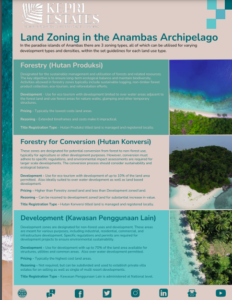 Land ownership and usage rights are aligned with Indonesia’s land tenure laws and decrees. For foreign investment, the 3 land title types below are relevant.
Land ownership and usage rights are aligned with Indonesia’s land tenure laws and decrees. For foreign investment, the 3 land title types below are relevant.
Common Land Tenure Categories
- Hak Guna Bangunan (HGB, Right to Build)
- Allows holders (including PT PMAs with foreign capital) to construct and occupy buildings on state land or privately held Hak Milik land for a set duration—commonly 30 years, renewable.
- Favored for commercial projects like hotels, resorts, or mixed-use complexes.
- Hak Pakai (Right to Use)
- Permits usage for specific, often shorter-term, applications—such as residential or state-sponsored activities.
- Foreign individuals can sometimes secure Hak Pakai titles under certain housing regulations.
- Hak Guna Usaha (HGU, Right to Cultivate)
- Relevant to agricultural, plantation, or large-scale aquaculture operations.
- In practice, less common in the Anambas but potentially viable for large integrated farmland-hotel concepts – “paddock to plate” initiatives.
Customary Rights (Adat)
In many Indonesian provinces, local communities hold traditional rights over certain forests, mangroves, or fishing grounds. Projects that overlap with adat territories must engage local leaders, often formalising consent via community agreements to avoid disputes. In the Anambas islands this is rarely a factor in development considerations, but may be relevant if developing close to existing population centres in sensitive areas.
Legal Process and Due Diligence
Among other considerations, buyers should always verify a property’s legal status ensuring no competing claims exist. Engaging Kepri Estates or regional lawyers who know Riau Islands customs and legal framework will save time and reduce acquisition costs.
8. Anambas Islands Zoning Types
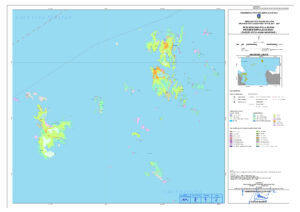 In the Anambas, zoning ensures that development unfolds in a strategic, balanced manner. It designates which areas can host commercial, industrial or residential development as well as conservation initiatives, while factoring in ecological vulnerabilities.
In the Anambas, zoning ensures that development unfolds in a strategic, balanced manner. It designates which areas can host commercial, industrial or residential development as well as conservation initiatives, while factoring in ecological vulnerabilities.
General Zoning Classifications
- Residential Zones: Primarily for local communities, small-scale housing, or village expansions.
- Commercial/Tourism Zones: Targeted for resorts, shops, restaurants, and tourism facilities.
- Industrial/Logistics Zones: Geared for fish processing, warehousing, or minimal manufacturing.
- Agriculture/Aquaculture Zones: Land or nearshore waters set aside for planting, livestock, or fish farming.
- Conservation Zones: Strict rules preserve reefs, mangroves, or other sensitive habitats. Tourism here often focuses on low-impact or research-based activities.
Property Law Zoning Categories
In the context of general land uses, Indonesia, and the Anambas islands, classify sites as either “white,” “pink,” or “yellow”. General guidelines for each type are.
- White – Generally open for immediate development, typically up to 70% roof cover.
- Pink – Allows 10% construction but places extra restrictions on permanent structures.
- Yellow: Water-based tourism facilities (e.g., floating bungalows) might be feasible under marine zoning provisions, but no terrestrial development permitted.
Pink and Yellow zoned land can be rezoned on application (pink to white, and yellow to pink to white), and has the potential to substantially increase land values, however investors should assure themselves of the process, costs and probabilities of approvals before embarking on such value adding strategies.
9. Anambas Islands Development Zones
Beyond simple zoning categories, certain sections of the Anambas have been flagged as strategic “Anambas Islands Development Zones,” guiding investors toward areas with existing infrastructure or minimal environmental conflict. This approach harnesses synergy, reduces cumulative impacts and promotes complementary businesses (e.g., restaurants and complementary services near a resort).
Tourism Development Areas
Palmatak, Siantan, Siantan Timur and Mengkait are some key areas zoned for premium eco tourism, that are aligned with exclusive island resort developments. Areas adjacent to these and on the routes to main population centres in Siantan and Jemaja are ideal locations for verticals and related businesses.
The planned seaplane dock and marina area on the South East of Siantan island and adjacent to the planned Sintan / Bajau island bridge is a good example of how verticals can align with development in the aforementioned areas, and provide convenient feeder traffic to them.
Industrial and Logistics Corridors
While not extensive, a few islands and villages host marine logistics hubs or fishery related enterprises, Air Sena village with it’s deepwater access and extensive aquaculture for live finfish export is a good example of this. The government occasionally revisits these corridors, especially if new proposals or foreign investment emerges.
Special Economic Zones (Potential)
Indonesia commonly uses SEZs to spur growth through tax incentives, simpler licensing, and infrastructural support. In Riau province, Batam SEZ is a good example of this. Though the Anambas are yet to formalise an SEZ, local policymakers have hinted that advanced tourism or fisheries-based corridors might be prime candidates as development continues to grow.
10. Policy and Regulatory Frameworks
Any stakeholder examining Anambas Islands Development should note Indonesia’s multi-layered policy environment, spanning national, provincial, and regency levels.
Indonesia continues to simplify and refine foreign investment laws in order to attract increasing overseas investment and the flow through benefits it will bring to taxes, employment and infrastructure improvements. Facilitating and assisting foreign investment in the Anambas archipelago is a key focus of regional and provincial government.
Some relevant laws related to investment and development are.
National Laws
- Law No. 26/2007 on Spatial Planning: Establishes how provinces define land use.
- Law No. 32/2009 on Environmental Protection: Mandates AMDAL (EIA) for large or sensitive projects.
- Omnibus Law on Job Creation (Law No. 11/2020): Streamlines foreign investment protocols, encourages real estate deals via PT PMA structures, and modernises permit systems.
Provincial and Regency Regulations
- Riau Islands Spatial Plan (RTRW): Sets broad objectives for land and marine usage.
- Local Bylaws (Perda): Tackle specifics like coastal buffer rules, reef protection, seasonal fishing closures, or resort capacity limits.
Community Involvement
Public consultations with local communities is a standard procedure for development in the Anambas islands, and ensure that local fisher groups, village elders, or NGOs can voice concerns and support. Developers who engage local stakeholders will often find this local support will facilitate smoother permitting, higher social acceptance, and importantly, a ready source of support and local resources to minimise development timelines and costs.
11. The Anambas Islands Development Process
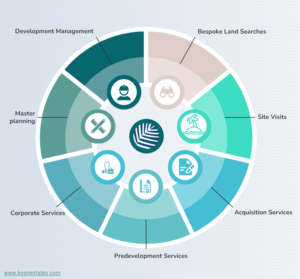
Though each project is unique, most follow a familiar roadmap from concept to completion.
11.1. Site Selection
- Site Selection – Developers or investors identify suitable parcels, verifying land titles, zoning compatibility, and environmental constraints.
11.2. Land Acquisition
- Due Diligence – Boundary surveys, BPN title checks, engage legal representation
- Purchase – Establish PT PMA company, PPJB to purchase, deposits, settlement.
11.3. Licensing and AMDAL
- Online Single Submission (OSS) – Investors register company and project details, obtaining multi-agency reviews and approvals.
- Environmental Impact Assessment (AMDAL) – Large-scale or sensitive projects submit impacts and mitigations (where applicable).
11.4. Predevelopment
- Architectural/Engineering Designs – Site data acquisition, master plans, development designs and layouts.
- Public Consultations – Socialise plans with local residents, local government, and garner project development support.
11.5. Development
- Plan, Schedule and Budget – Master schedule, sequences, tenders, vendor engagement, commence works.
- Monitoring – Site project management, schedule inspections, acquire licenses for operations.
11.6. Operations
- Tourism Launch or Facility Opening – Hiring local staff, marketing, training, soft launch, final opening.
- Ongoing CSR – Continue community outreach, environmental monitoring, philanthropic endeavors to maintain support.
12. The Anambas Islands Value Proposition
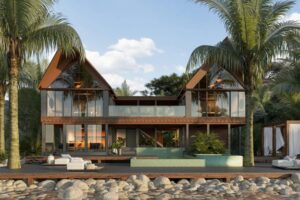 The archipelago’s combination of unique attributes make a compelling case for premium eco tourism development. A convergence of geography, technology, government support, and an exceptional development precedent, indicate that a timely investment in the province will provide an exceptional result for developers. A few attributes to consider are.
The archipelago’s combination of unique attributes make a compelling case for premium eco tourism development. A convergence of geography, technology, government support, and an exceptional development precedent, indicate that a timely investment in the province will provide an exceptional result for developers. A few attributes to consider are.
- Very low (but increasing) land prices – starting at less than US$4.50/m2
- An exceptional environment – tropical wilderness, coral triangle, designated marine conservation area, authentic cultural immersion
- Superior Guest Experiences – Diving, coral fields, rare flora and fauna, palm lined beaches, uninhabited wilderness islands
- Zoning laws limiting competition – Development zoned land limited to selected islands and beaches only, restricting future competition
- Ongoing infrastructure investment, airport expansions, seaplane terminal, expanded ferry terminal and ports
- Extensive opportunity for verticals – Diving, transport, retail, services, infrastructure, agriculture, mariculture and aquaculture
- Access – Less than 300 km from Singapore and its 400 direct global destinations
- Flexible development laws – Opportunities to value add from subdivision, private villa estates, short and long stay tourism
- Exceptional development yields – Precedent yields up to US$35,000 per room night from the only existing 5 star resort
- Market Gaps – No current or planned development in the US$200 – US$800 per night range (3 to 4.5 stars)
The Anambas value proposition compared to other recognised development areas – globally, regionally and nationally, is detailed in our comprehensive article “Anambas Islands vs Others“, which is also the next article in this series.
12.1 – Case Study – The Bawah Reserve
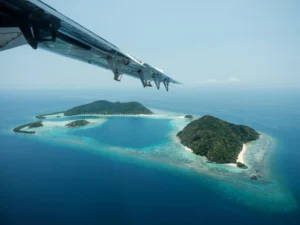 No article on Anambas islands development opportunities would be complete without mentioning the only existing 5 star development in the province – The Bawah Reserve.
No article on Anambas islands development opportunities would be complete without mentioning the only existing 5 star development in the province – The Bawah Reserve.
The property exemplifies luxury eco-tourism successfully operating within the Anambas archipelago. Built with minimal environmental impact, this high-end resort offers beach and overwater villas, advanced wastewater treatment, and robust coral reef protection programs. Guests pay between US$1,800 pp per night, up to US$35,000 for the uber luxury Elang Wing private residence, testifying to the premium value that travellers assign to the exclusivity and pristine natural environment of the Anambas islands.
From an investment standpoint, Bawah Reserve’s strong occupancy rates highlight the exceptional yields that a carefully planned hospitality project in this unique environment can generate. By blending sustainability with upscale amenities, the resort maintains an outstanding reputation, drawing eco-conscious global travellers while preserving local marine ecosystems. This success story underscores the vast opportunity for developers who combine top-tier design, environmental stewardship, and well-crafted guest experiences as part of any Anambas Islands Development.
The development has not only hit it out of the park in a commercial sense, but in its ESG credentials and social initiatives, it is up there with the best. From its extensive conservation initiatives, through to local employment and engagement, it is a valuable and uplifting asset for the Anambas Islands community and its people, as well as a exceptionally lucrative investment for its owner.
13. Future Outlook and Conclusion
The Anambas Islands inhabit a pivotal point in Indonesia’s outer-island development narrative. Untouched reefs, scenic coves, and strategic maritime positioning converge with supportive government policies. Meanwhile, higher-end tourism, real estate interest, and fisheries modernization suggest a bright path forward—if managed judiciously.
Key Takeaways
- Sustainability Meets Profit: The archipelago’s charm stems from natural beauty, but that same beauty underpins the business case.
- Multiple Entry Points: Whether in real estate, hospitality, or other ecotourism ventures, the Anambas hold room for new ventures.
- Legal and Social Nuances: Understanding land titles (HGB, Hak Milik, etc.) and local zoning (White, Pink, Yellow) is crucial.
- Market Gaps: No existing or planned 3 to 4.5 star developments, limited competition, exceptional investment yield.
Balancing Growth and Preservation
Moving forward, consistent funding, community-inclusive planning, and data-driven environmental management will determine the region’s trajectory in the longer term. The Indonesian government’s emphasis on safeguarding marine resources also means that sustainable development will ensure superior guest experiences for generations to come . Developers who align with this principle stand to gain local trust, fewer regulatory hurdles, and a competitive edge, with little to no competition, maintaining uplift and yield for the longer term.
For those inspired by the business opportunities, Kepri Estates and other reputable agencies offer real-time property listings, legal consultation, and feasibility analysis. By weaving ESG considerations and cultural respect into project frameworks, your Anambas Islands Development has the potential to evolve into a globally recognised model for advancing ESG standards, whilst maximising uplift and yield.
The archipelago offers a compelling and credible business case to maximise investment yield. When anchored by strong environmental stewardship, inclusive social engagement, and prudent legal structuring, investors can realise exceptional returns while preserving the very ecosystems that make the Anambas Islands so attractive to the premium eco tourism sector.